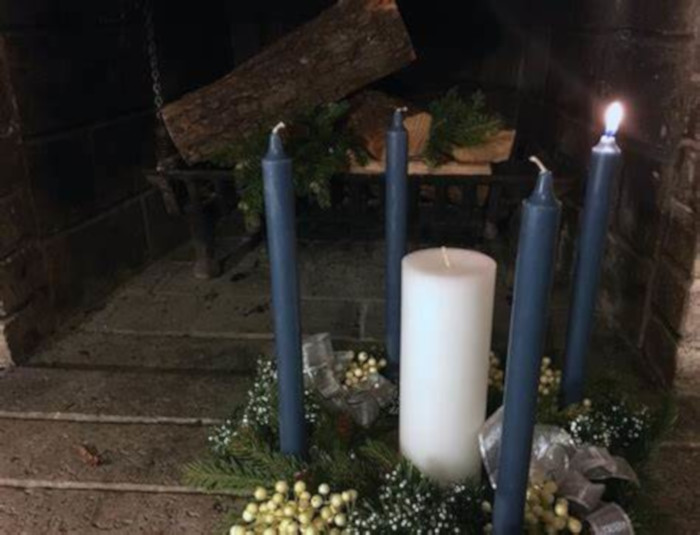Forget red and green: Make it a blue holiday instead
By Diana Butler Bass November 25, 2016
Advent calendars, the kind with little windows and chocolates inside, showed up in the grocery store a few days after Halloween. I was grateful for the reminder that Advent is coming. I am prone to forgetting that until the Sunday it arrives, as it does this year, a few days after Thanksgiving, and it catches me unaware.
Advent is the season of spiritual preparation leading up to Christmas — the four Sundays in advance of Christmas Day. Those Advent calendars in the grocery store are a token of an ancient religious practice to mark sacred time, one of the few aspects of the upcoming holiday season that remains nearly untouched by secularization or consumerism. For Christians, Advent is a time of waiting, listening and preparing for the birth of Jesus.
Our family always has an Advent calendar. But we also have an Advent wreath at home with four candles. We light one each Sunday and read a poem or prayer. Forewarned by the grocery store display, I remembered to buy the candles early this year — to be prepared for the season of preparation.
The local craft store carried a large selection of purple and pink candles, the customary colors for Advent wreaths. The purples traditionally symbolize penitence, while the pink symbolizes joy. I put three purple candles and a single pink one in my basket. Then I noticed nearby another box of candles — blue — an ambiguous shade, not too light, not too dark, that in-between color of neither day nor night.
I looked at the candles in my basket — that penitent purple and that perky pink. I put them back. “Blue candles,” I thought. “That’s what I feel like this year. Not penitent. Not joyful. Just blue.”
Yes, I am blue. Judging from conversations with friends, reading social media and following the news, I know I am not alone. No matter how one voted in the recent election, it is obvious that happiness was a big loser in recent months — with therapists, psychologists and clergy reporting high levels of “Trump-related stress,” especially among women and minorities, including symptoms of depression, sleeplessness, anxiety and isolation.
The American Psychological Association discovered that more than half the population has experienced significant levels of stress in this election cycle, higher than they have ever measured in relation to a political event.
In recent weeks, I have been yelled at, threatened and ridiculed, had property defaced, been unfriended and blocked on social media. A neighbor witnessed a hate crime. Another friend arrived at church on a Sunday morning to malicious graffiti sprayed across the building. At first, I was angry. But now, I am just sad: blue, really blue.
Many people were dreading divided tables at Thanksgiving. Many more, I suspect, are finding it difficult to contemplate making merry at Christmas. “I’m just not in the mood,” a friend confessed to me last week, “Haven’t bought a single gift. I want to skip the whole holiday thing altogether.”
A blue Advent. That sounds about right.
And it is oddly appropriate.
In recent decades, some Christians have swapped out the penitential purple candles (and that pink one) for blue ones.
Advent should not be a mini-Lent; it is not a time to examine sins, engage in self-denial, and confession. It is not about penance. Rather, Advent is of a different spiritual hue: It is a time of waiting, of expectation, of hope in the darkness. The blue candles symbolize the color of the sky right before dawn, that time when the deepest dark is just infused with hints of light.
Blue holds the promise that the sun will rise, and that even after the bleakest, coldest, longest night, the light will break forth, as the new day arrives.
Blue may be the color of sadness, but blue is also the color of hope.
Many faiths and religious traditions have sacred days or times of waiting, of anticipation, of the expectation of enlightenment — that light breaks through the night. Diwali, Bodhi Day, Hanukkah, winter solstice, Advent. And those sorts of holy days are celebrated when darkness surrounds, when all seems lost. When we hurt and think we have been abandoned, when all promises seem broken. When we light candles against the night, trusting and believing that a greater light will arise. When a single flame becomes a conflagration of compassion and justice.
For Christians, Advent is not a time of opening up little windows with chocolates as we await the really big booty of presents under the tree on Christmas morning. That is not what we are waiting for. We are waiting for light, for God to renew and heal the world, a promise that we understand to have been mysteriously embodied in a baby born in a manger.
Advent recognizes a profound spiritual truth — that we need not fear the dark. Instead, wait there. Under that blue cope of heaven, alert for the signs of dawn. Watch. For you cannot rush the night. But you can light some candles. Sing some songs. Recite poetry. Say prayers.
Trust that waiting is active — making ready for what comes next. When the sun rises, there is much work to do.
In the meanwhile, make mine a blue Advent this year.
Diana Butler Bass is an award-winning author of nine books, including her most recent “Grounded: Finding God in the World — A Spiritual Revolution.” (Harper 2015).

